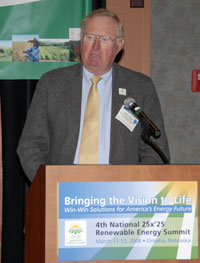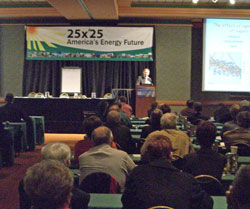The area around Seattle, Washington is known for its beautiful green surroundings, prompted by plentiful rain and moderate temperatures. But while the city itself might covered in lots of gray concrete, it is green when it comes to caring for the environment.
 Part of that commitment is the city’s dedication to biofuels and alternative forms of energy. This post on the Seattle Post-Intelligencer “Strange Bedfellows” blog was prompted by Mayor Greg Nickel’s announcement that he wanted all taxis in the city to get 30 miles per gallon. That prompted the authors to ask if the city is practicing the green ways it preaches, particularly in the use of biofuels:
Part of that commitment is the city’s dedication to biofuels and alternative forms of energy. This post on the Seattle Post-Intelligencer “Strange Bedfellows” blog was prompted by Mayor Greg Nickel’s announcement that he wanted all taxis in the city to get 30 miles per gallon. That prompted the authors to ask if the city is practicing the green ways it preaches, particularly in the use of biofuels:
A city spokeswoman, Katherine Schubert-Knapp, responded, in part:
“In addition to the diesel, (compressed natural gas), electric and hybrid vehicles cited below, we have 2,180 that run on gas. Many are subcompacts and I would expect those have high mileage ratings. Some are trucks and I expect those have low mileage ratings. The point is we buy vehicles that meet our business needs, such as police cars, utility trucks, fire engines, etc. When we can buy green versions of these, we do.”
So far, she said the city has:
– 384 hybrids and 95 cars that run on compressed natural gas.
– 47 electric off-road vehicles (22 scooters, 22 Segways, 2 electric bicycles and 1 neighborhood electric vehicle).
– 699 diesel-powered vehicles and “most run on biodiesel.” (The exceptions are things like fire engines and vehicles at remote locations, such as the Skagit, which cannot obtain the fuel). We use B20 (a fuel blend of 80% diesel and 20% biodiesel). We’re testing a B40 blend.
– 58 vehicles in our general-use motor pool and 45 are hybrid or natural gas vehicles. The Motorpool also features five Segways, three bicycles and two electric bicycles.
“We’re also looking for ways to make our specialty fleet green by replacing those vehicles, e.g., heavy-duty trucks, with more fuel-efficient vehicles. The challenge is the industry hasn’t produced a lot of those yet. We are starting to see some heavy-duty hybrid trucks come on the market and we purchased four last year.
In the long run, Seattle officials want 100 percent of their fleet to be clean and green, defined as using clean fuels and fuel-efficient, low-emission vehicles that still meet the city’s needs.
So, is Seattle truly a green city? Depends on what your standards are, but I would have to say the city is trying… more than many others can say.
 Closing out the 25x’25 Renewable Energy Summit was Allen Rider, member of the organization’s steering committee. He’s also a past president of New Holland North America.
Closing out the 25x’25 Renewable Energy Summit was Allen Rider, member of the organization’s steering committee. He’s also a past president of New Holland North America.

 The luncheon speaker here at the 25x’25 Renewable Energy Summit is Charles Zimmerman, VP, Prototype and New Format Development for Wal-Mart. I’ve been looking forward to meeting him since he’s got such a great name.
The luncheon speaker here at the 25x’25 Renewable Energy Summit is Charles Zimmerman, VP, Prototype and New Format Development for Wal-Mart. I’ve been looking forward to meeting him since he’s got such a great name. Raleigh, North Carolina has improved its bus system with some new buses that are roomier, more accessible, and possibly most importantly, run on biodiesel.
Raleigh, North Carolina has improved its bus system with some new buses that are roomier, more accessible, and possibly most importantly, run on biodiesel. Part of that commitment is the city’s dedication to biofuels and alternative forms of energy.
Part of that commitment is the city’s dedication to biofuels and alternative forms of energy.  One of today’s presenters at the 25x’25 Renewable Energy Summit was Dr. Steve Chu, Director,
One of today’s presenters at the 25x’25 Renewable Energy Summit was Dr. Steve Chu, Director,  The 4th Annual
The 4th Annual  Two-time Indy 500 winner and “Dancing with the Stars” champion Helio Castroneves was in Iowa Wednesday to promote the
Two-time Indy 500 winner and “Dancing with the Stars” champion Helio Castroneves was in Iowa Wednesday to promote the  According to the EIA’s Short-Term Energy Outlook, “The slowing economy combined with high petroleum prices is expected to constrain growth in U.S. consumption of liquid fuels and other petroleum products to just 40,000 barrels per day (bbl/d) in 2008. After accounting for increased ethanol use, U.S. petroleum consumption falls by 90,000 bbl/d.”
According to the EIA’s Short-Term Energy Outlook, “The slowing economy combined with high petroleum prices is expected to constrain growth in U.S. consumption of liquid fuels and other petroleum products to just 40,000 barrels per day (bbl/d) in 2008. After accounting for increased ethanol use, U.S. petroleum consumption falls by 90,000 bbl/d.” This year has been an exceptionally snowy one for much of the U.S., and some students in Michigan are making use of all the snow… while learning about the benefits of biofuels.
This year has been an exceptionally snowy one for much of the U.S., and some students in Michigan are making use of all the snow… while learning about the benefits of biofuels. “As diesel costs continue to skyrocket, this tax break will help ease the pain at the pump for consumers while helping to develop our state’s biodiesel industry,” Rounds said in a news release. “Biodiesel is an ideal alternative to petroleum-based fuel. It will not reduce mileage, and because of its increased lubricity, it is better for the engine.”
“As diesel costs continue to skyrocket, this tax break will help ease the pain at the pump for consumers while helping to develop our state’s biodiesel industry,” Rounds said in a news release. “Biodiesel is an ideal alternative to petroleum-based fuel. It will not reduce mileage, and because of its increased lubricity, it is better for the engine.”